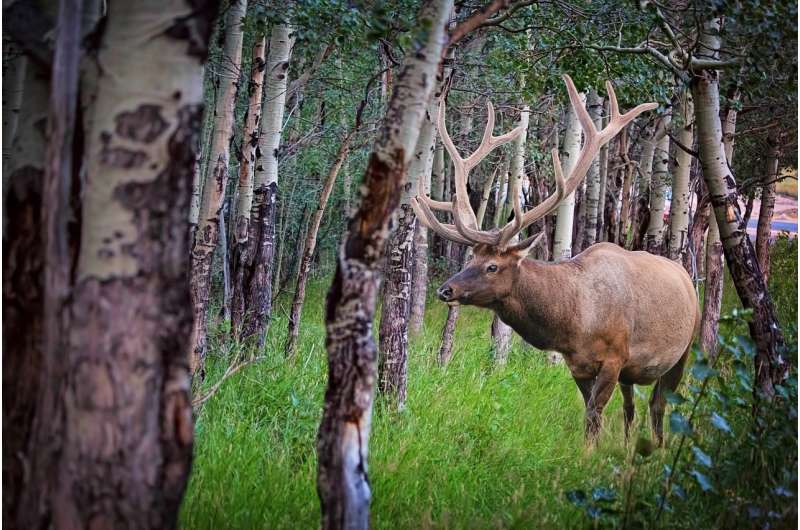This article has been reviewed according to Science X's editorial process and policies. Editors have highlighted the following attributes while ensuring the content's credibility:
fact-checked
reputable news agency
proofread
Plan to capture Minnesota elk, establish new herd gains momentum

An idea first floated a dozen years ago to capture wild elk and move them to an area in northeastern Minnesota is two years away from reality—a progression firmed up by the recent hirings of two full-time elk specialists.
This spring, Minnesota Department of Natural Resources big game biologist Kelsie LaSharr was promoted to the new permanent position of elk coordinator to oversee the establishment of Minnesota's fourth wild elk herd.
Similarly, the Fond du Lac Band of Lake Superior Chippewa just hired Makenzie Henk, a wildlife biologist who studied Roosevelt elk in California. She was hired from California's Catalina Island Conservancy and starts work July 29.
"She's going to be the elk biologist for Fond du Lac and our lead on all things elk," said Fond du Lac wildlife biologist Mike Schrage, who has led the band's exploration of elk starting in 2013.
The DNR has become a full-fledged partner in the project, also supported by the Legislature ($2.3 million in 2023), University of Minnesota, the Great Lakes Restoration Initiative, the Minnesota Environment and Natural Resources Trust Fund and Rocky Mountain Elk Foundation, among others.
Plans call for the new herd to be located around the Fond du Lac reservation in an area roughly bounded by Cloquet, Cromwell, Floodwood and the St. Louis River. Schrage and LaSharr said the first capture and relocation of animals is planned for the first three months of 2026. The animals will be sourced from two of the three existing wild herds roaming in northwestern Minnesota.
"The number will depend on how many elk will be available," Schrage said. "We will be trying to move what we consider to be surplus animals."
Fond du Lac and the DNR expect to capture and move 12 to 20 elk in the first year, Schrage said. The process will be repeated yearly, or as often as possible, until the new northeastern herd is self-sustaining, with a population large enough to be resilient against predation by the region's wolves and bears.
Ultimately, state-licensed hunters and tribal hunters would be able to harvest a limited number of bulls and cows from the new herd—just as they already do in the northwest region. But as Schrage has said in the past, hunting opportunities won't be realized for years. Eco-tourism is viewed as another future benefit of the project. Just as in the northwest, the elk won't be fenced.
"This is something we are doing now for our kids and our grandkids," he said.
Part of LaSharr's new job is to maintain elk population goals in the northwest, where private landowners have voiced mixed enthusiasm for the animals and disdain over crop damage they cause. Swings in the elk population affect annual hunting regulations.
This year, for instance, LaSharr said DNR will reduce harvest opportunities by offering only 10 license tags. Last year, the state issued 17 tags, and lottery winners of those tags bagged 11 elk. In 2004–05, the number of license tags offered by DNR was five.
The conservative hunting posture for this year relates to the DNR's avoidance of over-harvesting at a time when surplus elk are needed for relocation.
With little to no snow on the ground in January, the agency couldn't run its annual aerial survey of elk, creating uncertainty this year about the population. Together, all three existing elk herds in northwest Minnesota account for fewer than 300 elk. The largest of those herds, known as Caribou-Vita, is shared with Manitoba.
Fairly new to elk management in the northwest is harvest activity by members of Red Lake Nation across 1863 Treaty lands that extend beyond the reservation. There was a modest harvest by Red Lake tribal hunters in 2022 followed last fall by a more aggressive hunt that carried a harvest cap—not exceeded—of 15 elk.
"We don't really know what their target is this year," LaSharr said. "We hope no more than 10."
Public outreach will be another emphasis by LaSharr, keeping counties, legislators, law enforcement groups, farmers, deer hunters, conservation groups and other direct stakeholders abreast of new developments. She'll also be running webinars and newsletters for the general public.
Meanwhile, Minnesota will soon be conducting an elk movement study by deploying tracking collars on a number of animals starting in January.
All the while, LaSharr, Henk and other wildlife officials will be honing strategies on how, when and where to capture elk, move them east in livestock trailers to a holding area and allow them to acclimate to new surroundings before releasing them back to the wild in the spring.
"Elk are a super-exciting, charismatic, mega-fauna species," LaSharr said. "I love elk and the opportunity … to be able to take this position and run with it."
2024 StarTribune. Distributed by Tribune Content Agency, LLC.



















